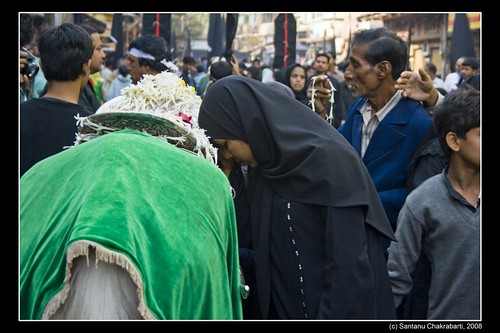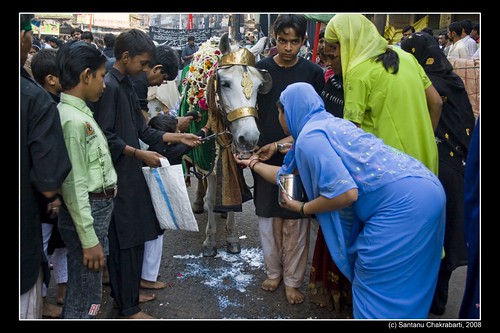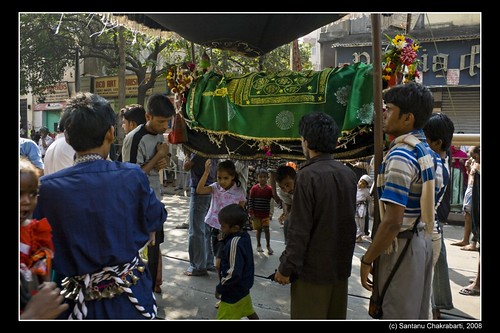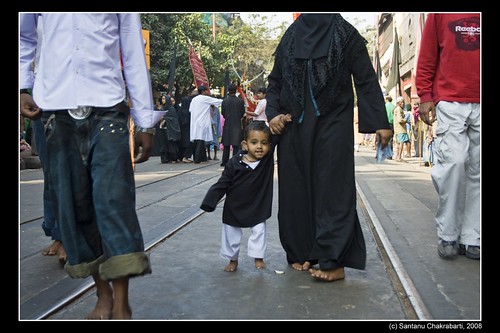Its long since I haven't been around. Mostly due to some network failure at the beginning, but then I got busy with shooting the events that were coming up. After the autumn festival the two months of winter season, that is December and January, are most eventful. I wish to share my photographs on Muharram here. Others are following by soon.

Muharram is the first month of Islamic lunar calendar, Hijrah. It is one of the four months that have been designated as Holy according to the Islamic belief, the other three being - Dhul-Qa'adah (Zulqa'dah), Dhul-Hijjah (Zulhijjah) and Rajab. However the first ten days of the month are considered as most sacred. Fasting is advocated in the month of Muharram, but the fasting on the tenth day of Muharram, called Ashura, is particularly important, as it is supposed to lead to great rewards.


 Muharram is an important month to the people of Islamic faith. Many auspicious events of Quranic history are believed to have taken place during this month, specially during the tenth day. Some of the events are: The Prophet Adam was born and his repentance was accepted on this day, the Prophet Abraham was saved from the Fire, the Prophet Ishmael was delivered from the Sacrifice, the Prophet Joseph was reunited with his father,
Muharram is an important month to the people of Islamic faith. Many auspicious events of Quranic history are believed to have taken place during this month, specially during the tenth day. Some of the events are: The Prophet Adam was born and his repentance was accepted on this day, the Prophet Abraham was saved from the Fire, the Prophet Ishmael was delivered from the Sacrifice, the Prophet Joseph was reunited with his father,  the Prophet Job was cured of his illness and the Prophet Solomon was ordained as king; however no accurate historical evidences could be found for them.
the Prophet Job was cured of his illness and the Prophet Solomon was ordained as king; however no accurate historical evidences could be found for them.
Shiite Muslims observes the first ten days of Muharram to commemorate the martyrdom of Imam Hussain and his family, the grandson of the holy Prophet. Hence Muharram is not a festival in the celebratory sense to the sect as it mourns the Karbala tragedy. Muslims build paper and bamboo replica of the martyr's tomb, called Tajiya or Tazia, and carry them into the street in a procession to mourn Imam Hussain's brutal assassination. Mourners walk barefoot, beat their chests and cry out the name of Imam Hussain.
of Muharram to commemorate the martyrdom of Imam Hussain and his family, the grandson of the holy Prophet. Hence Muharram is not a festival in the celebratory sense to the sect as it mourns the Karbala tragedy. Muslims build paper and bamboo replica of the martyr's tomb, called Tajiya or Tazia, and carry them into the street in a procession to mourn Imam Hussain's brutal assassination. Mourners walk barefoot, beat their chests and cry out the name of Imam Hussain. Some plaintive verses are recited to signify that Hussain and his family had to suffer terrible thirst during their murder. The youths whip them with chains or hit them with knives to draw blood out of their body to symbolize the physical pangs that Imam Hussain had to suffer. Horses decorated as a battle horse with swords, etc. are also taken out in the procession in memory of Hussain's horse, Duldul.
Some plaintive verses are recited to signify that Hussain and his family had to suffer terrible thirst during their murder. The youths whip them with chains or hit them with knives to draw blood out of their body to symbolize the physical pangs that Imam Hussain had to suffer. Horses decorated as a battle horse with swords, etc. are also taken out in the procession in memory of Hussain's horse, Duldul.
 Sunni Muslims also commemorate Imam Hussain's martyrdom but in a less demonstrative manner, concentrating instead on its spiritual aspect.
Sunni Muslims also commemorate Imam Hussain's martyrdom but in a less demonstrative manner, concentrating instead on its spiritual aspect.
The word Muharram is derived from the word Haram, which actually means forbidden; it also means respect. Hence the month of Muharram encourages people to forbid themselves from all worldly pleasures and  to respect the great children of the Mother Earth by commemorating their sacrifices towards the establishment of Truth and Justice.
to respect the great children of the Mother Earth by commemorating their sacrifices towards the establishment of Truth and Justice.
More photos in my Flickr.
Resources
=========
1. http://www.jannah.org/articles/muharram.html
2. http://www.indiawijzer.nl/tourism_travelling_to_india/fairs_and_festivals/march/muharram.htm
3. http://www.alinaam.org.za/library/imuharram.htm
4. http://www.indiaparenting.com/indianculture/festivals/fest009.shtml
5. http://muslims-r-us.blogspot.com/2008/01/what-really-happened-on-10th-muharram.html Full story...













